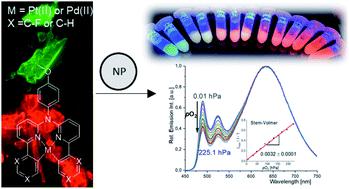当前位置:
X-MOL 学术
›
Chem. Sci.
›
论文详情
Our official English website, www.x-mol.net, welcomes your feedback! (Note: you will need to create a separate account there.)
Ligand-controlled and nanoconfinement-boosted luminescence employing Pt(II) and Pd(II) complexes: from color-tunable aggregation-enhanced dual emitters towards self-referenced oxygen reporters
Chemical Science ( IF 8.4 ) Pub Date : 2021-1-6 , DOI: 10.1039/d0sc06126c Iván Maisuls 1, 2 , Cui Wang 3, 4 , Matias E Gutierrez Suburu 1, 2 , Sebastian Wilde 1, 2 , Constantin-Gabriel Daniliuc 5 , Dana Brünink 6 , Nikos L Doltsinis 6 , Stefan Ostendorp 7 , Gerhard Wilde 7 , Jutta Kösters 2 , Ute Resch-Genger 3 , Cristian A Strassert 1, 2
Chemical Science ( IF 8.4 ) Pub Date : 2021-1-6 , DOI: 10.1039/d0sc06126c Iván Maisuls 1, 2 , Cui Wang 3, 4 , Matias E Gutierrez Suburu 1, 2 , Sebastian Wilde 1, 2 , Constantin-Gabriel Daniliuc 5 , Dana Brünink 6 , Nikos L Doltsinis 6 , Stefan Ostendorp 7 , Gerhard Wilde 7 , Jutta Kösters 2 , Ute Resch-Genger 3 , Cristian A Strassert 1, 2
Affiliation

|
In this work, we describe the synthesis, structural and photophysical characterization of four novel Pd(II) and Pt(II) complexes bearing tetradentate luminophoric ligands with high photoluminescence quantum yields (ΦL) and long excited state lifetimes (τ) at room temperature, where the results were interpreted by means of DFT calculations. Incorporation of fluorine atoms into the tetradentate ligand favors aggregation and thereby, a shortened average distance between the metal centers, which provides accessibility to metal–metal-to-ligand charge-transfer (3MMLCT) excimers acting as red-shifted energy traps if compared with the monomeric entities. This supramolecular approach provides an elegant way to enable room-temperature phosphorescence from Pd(II) complexes, which are otherwise quenched by a thermal population of dissociative states due to a lower ligand field splitting. Encapsulation of these complexes in 100 nm-sized aminated polystyrene nanoparticles enables concentration-controlled aggregation-enhanced dual emission. This phenomenon facilitates the tunability of the absorption and emission colors while providing a rigidified environment supporting an enhanced ΦL up to about 80% and extended τ exceeding 100 μs. Additionally, these nanoarrays constitute rare examples for self-referenced oxygen reporters, since the phosphorescence of the aggregates is insensitive to external influences, whereas the monomeric species drop in luminescence lifetime and intensity with increasing triplet molecular dioxygen concentrations (diffusion-controlled quenching).
中文翻译:

使用 Pt(II) 和 Pd(II) 配合物的配体控制和纳米限制增强发光:从颜色可调聚集增强双发射器到自参考氧报告基因
在这项工作中,我们描述了四种新型 Pd( II ) 和 Pt( II ) 配合物的合成、结构和光物理表征,这些配合物带有四齿发光配体,在室温下具有高光致发光量子产率 ( Φ L ) 和长激发态寿命 ( τ ) ,其中结果通过 DFT 计算来解释。将氟原子掺入四齿配体有利于聚集,从而缩短了金属中心之间的平均距离,这为金属-金属-配体电荷转移(3 MMLCT)准分子提供了可及性,相比之下,准分子充当红移能量陷阱与单体实体。这种超分子方法提供了一种优雅的方法来实现 Pd( II ) 配合物的室温磷光,否则由于较低的配体场分裂,这些配合物会被解离态的热群体猝灭。将这些复合物封装在 100 nm 尺寸的胺化聚苯乙烯纳米粒子中,可实现浓度控制的聚集增强双发射。这种现象促进了吸收和发射颜色的可调性,同时提供了支持将Φ L增强至约 80% 并将τ扩展超过 100 μs 的刚性环境。此外,这些纳米阵列构成了自参考氧报告基因的罕见例子,因为聚集体的磷光对外部影响不敏感,而单体物种的发光寿命和强度随着三线态分子双氧浓度的增加而下降(扩散控制猝灭)。
更新日期:2021-01-20
中文翻译:

使用 Pt(II) 和 Pd(II) 配合物的配体控制和纳米限制增强发光:从颜色可调聚集增强双发射器到自参考氧报告基因
在这项工作中,我们描述了四种新型 Pd( II ) 和 Pt( II ) 配合物的合成、结构和光物理表征,这些配合物带有四齿发光配体,在室温下具有高光致发光量子产率 ( Φ L ) 和长激发态寿命 ( τ ) ,其中结果通过 DFT 计算来解释。将氟原子掺入四齿配体有利于聚集,从而缩短了金属中心之间的平均距离,这为金属-金属-配体电荷转移(3 MMLCT)准分子提供了可及性,相比之下,准分子充当红移能量陷阱与单体实体。这种超分子方法提供了一种优雅的方法来实现 Pd( II ) 配合物的室温磷光,否则由于较低的配体场分裂,这些配合物会被解离态的热群体猝灭。将这些复合物封装在 100 nm 尺寸的胺化聚苯乙烯纳米粒子中,可实现浓度控制的聚集增强双发射。这种现象促进了吸收和发射颜色的可调性,同时提供了支持将Φ L增强至约 80% 并将τ扩展超过 100 μs 的刚性环境。此外,这些纳米阵列构成了自参考氧报告基因的罕见例子,因为聚集体的磷光对外部影响不敏感,而单体物种的发光寿命和强度随着三线态分子双氧浓度的增加而下降(扩散控制猝灭)。


























 京公网安备 11010802027423号
京公网安备 11010802027423号